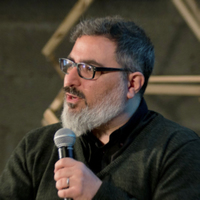Research Interests:
The goal of our research is to question the Global North’s narratives of the Future through alternative vernacular semiotic constructions. We will analyze the impact that American vernacular semioverses have on the possibility of... more
The goal of our research is to question the Global North’s narratives of the Future through alternative vernacular semiotic constructions. We will analyze the impact that American vernacular semioverses have on the possibility of generating decolonial figurations of alternative futures, based on the theoretical framework of what we call Xenofuturism. Having its roots in Latin America, Xenofuturism has two complementary aspects: the recovery of an active memory of decolonial deconstruction and the understanding of radical alterity. Within these semioverses, we will explore the Aymara cultural figurations for which the future is not ahead but behind, disorienting us from the present, the only temporal dimension in which we exist. In the ancestral cosmogony of the Bolivian-Peruvian Andean, where the Aymara culture stems from the idea of future-past, or that the past can be seen as future, is central. Temporal hybridity tears apart the linearity of Western time and outlines the emergenc...
Research Interests:
Research Interests:
The need to raise an own epistemological framework in which the design´s researchers are developed and consolidated becomes known with the design creative disciplines, development research works. However, this phenomenon has been extended... more
The need to raise an own epistemological framework in which the design´s researchers are developed and consolidated becomes known with the design creative disciplines, development research works. However, this phenomenon has been extended in the last twenty years, from an increment of the research lines and projects and a growth of the critic mass of post grades and doctorates. The existence of this situation turns necessary the proposal of certain guesswork about the “epistemology of design”, which a construction process and to be genuine must be horizontal, interdisciplinary, systematic, heterodox and collective. Basically, its elaboration is been carrying out from the own design disciplinary field, as for the complex joints of looks toward the design project and research field problems, demonstrates to be vitally needed to face the mentioned epistemology development.
Research Interests:
Research Interests: Computer Science, Cultural Heritage, Digital Fabrication, Cultural Heritage Conservation, Heritage Conservation, and 11 moreCNC Machine tools programming, Cultural Heritage Management, Digital Fabrication (Architecture), Parametric Design, Rhinoceros, Workshops, Parametric design architecture, trambauer, vidialab, labfab, and depinfo
Research Interests:
Este articulo surge de una experiencia pedagogica basada en el desarrollo de una metodologia para la investigacion en el ambito de la construccion de problemas de investigacion en arquitectura. La hipotesis que sostuvo la experiencia fue... more
Este articulo surge de una experiencia pedagogica basada en el desarrollo de una metodologia para la investigacion en el ambito de la construccion de problemas de investigacion en arquitectura. La hipotesis que sostuvo la experiencia fue entender a la tropologia como una herramienta para figuracion de problemas epistemicos y heuristicos. La metodologia utilizada consistio en desarrollar un aparato que genera problemas de investigacion a partir del reconocimiento de un topos –un topico o lugar comun epistemico perteneciente al campo disciplinar de la carrera– y su puesta en relacion con un tropos -una figuracion-. Por un lado, el topos fue elegido por cada una/o de las/los estudiantes en funcion de sus problematicas socio-culturales y segun sus situaciones vivenciales concretas en el marco de la arquitectura y el urbanismo. Por el otro, el tropos surgio de un ejercicio de desplazamiento figurativo que permitio dar cuenta de las potencialidades predicativas antes que denominativas del...
Research Interests:
These eight storyboards were exhibited at the 16th Annual International Conference of the Architectural Humanities Research Association at the University of Dundee, UK. They were designed by Paul Guzzardo and Gustavo Cardon. The tableaus... more
These eight storyboards were exhibited at the 16th Annual International Conference of the Architectural Humanities Research Association at the University of Dundee, UK. They were designed by Paul Guzzardo and Gustavo Cardon. The tableaus are set in barrios in Buenos Aires, Argentina. They were developed for two Buenos Aires architectural graduate workshops and UNESCO presentations in France, Lithuania and Sweden.1 The storyboards were proposed as an alternative to the desiccated storylines that gag most urban design briefs. They offer a new mythic stew, as “triage way stations” to map a way out of the digital mesh-up we are slapped hard against and as mythic blueprints for a line of firewalls against weaponized data. Despite the fact that digital buckshot is coming at hyper-speed, a conversation about myth and the practice of architecture has been ignored. Myths contain seeds of new stories, stories that incrementally increase intelligence.
